Wild mammals have declined by 85% since the rise of humans, but there is a possible future where they flourish
Wild mammal biomass has declined by 85% since the rise of humans. But we can turn things around by reducing the amount of land we use for agriculture.
Summary
A diverse range of mammals once roamed the planet. This changed quickly and dramatically with the arrival of humans. Since the rise of humans, wild land mammal biomass has declined by 85%. Our history with them has been a zero-sum game: we either hunted them or took over their habitats with the expansion of agricultural lands. Without these wild habitats to expand into and produce food on, the rise of humans would have been impossible.
But, for the first time in human history, we have the opportunity to turn this into a net-sum game: we can produce enough food from a smaller land area, making it possible for them to flourish again.
Travel back 100,000 years and the planet was rich with a wide array of wild mammals. Mammoths roamed across North America; lions across Europe; 200-kilogram wombats in Australasia; and the ground sloth lounged around South America.
They’re now gone. Since the rise of humans, several hundred of the world’s largest mammals have gone extinct.
While we often think of ecological damage as a modern problem our impacts date back millennia to the times in which humans lived as hunter-gatherers. Our history with wild animals has been a zero-sum game: either we hunted them to extinction, or we destroyed their habitats with agricultural land. Without these natural habitats to expand into and produce food on, the rise of humans would have been impossible. Humans could only thrive at the expense of wild mammals.
But it doesn’t have to be this way. This century marks a pivotal moment: for the first time in human history there is the opportunity for us to thrive alongside, rather than compete with, the other mammals that we share this planet with.
In this article I want to take a look at how the world’s mammals have changed in the past, and how we can pave a better way forward.
As we’ll see, our long history with the other mammals is really a story about meat. Humans have always, and continue to have, a strong drive to eat meat. For our hunter-gatherer ancestors life was about plotting a hunt against the giant 200-kilogram wombat. This later became a story of how to produce the equivalent of a giant wombat in the field. Now we’re focused on how we can produce this in the lab.
The decline of wild mammals has a long history
To understand how the richness of the mammal kingdom has changed we need a metric that captures a range of different animals and is comparable over time. We could look at their abundance – the number of individuals we have – but this is not ideal. We would be counting every species equally, from a mouse to an elephant and this metric would therefore make an ecosystem taken over by the smallest mammals look much richer than one in which bigger mammals roam: if the world’s mouse populations multiplied and multiplied – maybe even to the detriment of other animals – then this abundance metric might suggest that these ecosystems were thriving.
Instead, ecologists often use the metric biomass. This means that each animal is measured in tonnes of carbon, the fundamental building block of life.1 Biomass gives us a measure of the total biological productivity of an ecosystem. It also gives more weight to larger animals at higher levels of the ecological ‘pyramid’: these rely on well-functioning bases below them.
I have reconstructed the long-term estimates of mammal terrestrial biomass from 100,000 BC through to today from various scientific sources.2 This means biomass from marine mammals – mainly whales – is not included. The story of whaling is an important one that I cover separately here. This change in wild land mammals is shown in the chart. When I say ‘wild mammals’ from this point, I’m talking about our metric of biomass.
If we go back to around 100,000 years ago – a time when there were very few early humans and only in Africa – all of the wild land mammals on Earth summed up to around 20 million tonnes of carbon. This is shown as the first column in the chart. The mammoths, and European lions, and ground sloths were all part of this.
By around 10,000 years ago we see a huge decline of wild mammals. This is shown in the second column. It’s hard to give a precise estimate of the size of these losses millennia ago, but they were large: likely in the range of 25% to 50%.3
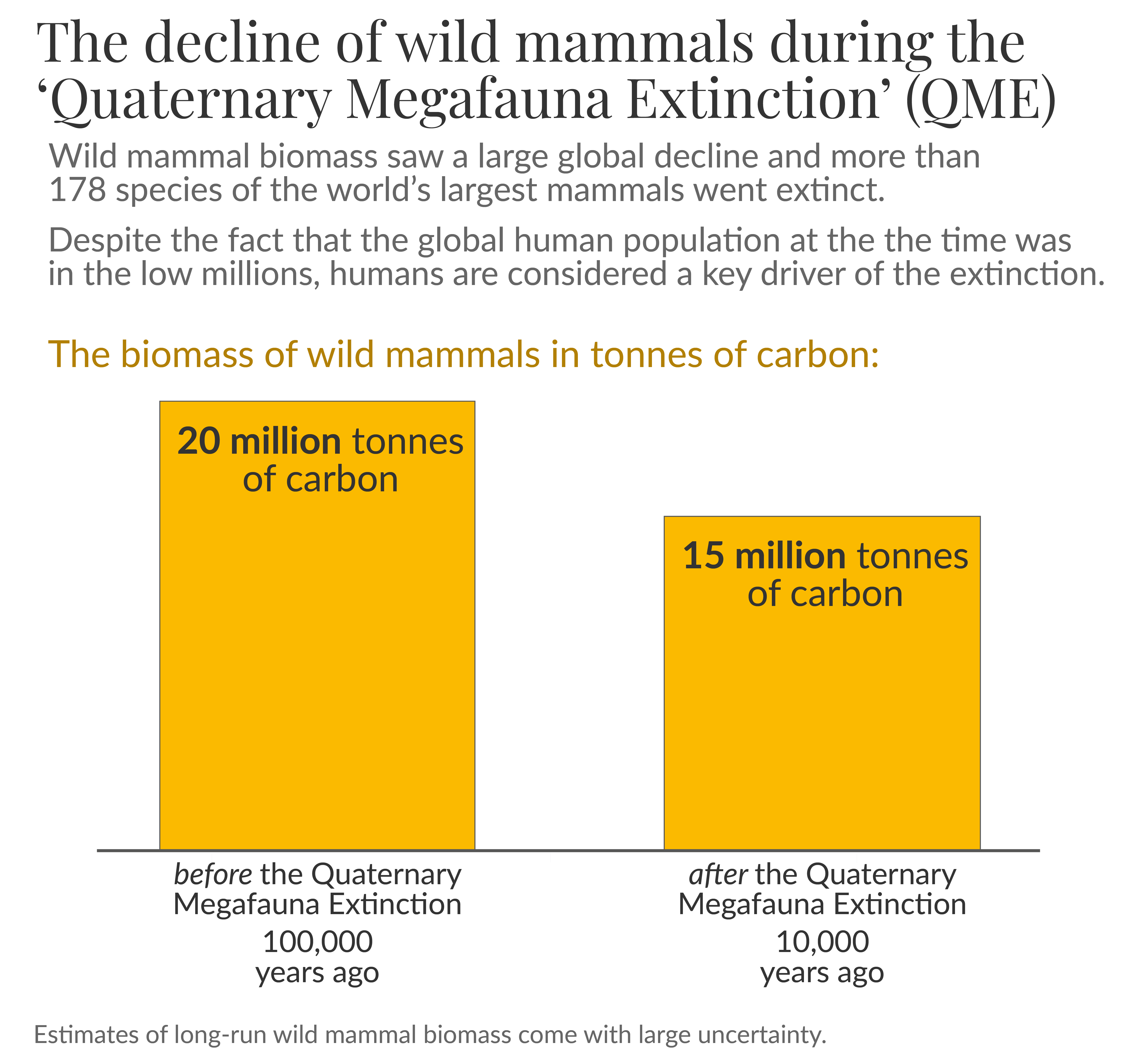
It wasn’t just that we lost a lot of mammals. It was almost exclusively the world’s largest mammals that vanished. This big decline of mammals is referred to as the Quaternary Megafauna Extinction (QME). The QME led to the extinction of more than 178 of the world’s large mammals (‘megafauna’).
Many researchers have grappled with the question of what caused the QME. Most evidence now points towards humans being a key driver.4 I look at this evidence in much more detail in a related article. Most of this human impact is thought to have come through hunting. There might also have been smaller local impacts through fire, the introduction of invasive species, and other changes to natural landscapes. You can trace the timing of mammal extinctions by following human expansion across the world’s continents. When our ancestors arrived in Europe the European megafauna went extinct; when they arrived in North America the mammoths went extinct; then down to South America, the same.
What’s most shocking is how few humans there were at the time. There were likely fewer than 5 million peoplein the world.5 Around half the population of London today.6
A global population half the size of London contributed to many of the world’s largest mammals to extinction. The per capita impact of our hunter-gatherer ancestors was huge.
The romantic idea that our hunter-gatherer ancestors lived in harmony with nature is flawed. Humans have never been ‘in balance’ with nature. Trace the footsteps of these tiny populations of the past and you will find extinction after extinction after extinction.
Hunting to farming: how human populations now compete with wild mammals
We’re now going to fast-forward to our more recent past. By the year 1900, wild mammals had seen another large decline.
By this point, the pressures on wild mammals had shifted. The human population had increased to 1.7 billion people. But the most important change was the introduction of farming and livestock. We see this in the top panel of the chart. This shows the per capita agricultural land use over these millennia – a reflection of how humans got their food.7 Before the agricultural revolution around 10,000 years ago, our food came from hunting and gathering. Agricultural land use was minimal although as we’ve already seen, per capita impacts were still high through hunting. We then see a clear transition point, where agricultural land use begins to rise.
The rise of agriculture had both upsides and downsides for wild mammals. On the one hand, it alleviated some of the direct pressure. Rather than hunting wild mammals we raised our own for meat, milk, or textiles. In this way, the rise of livestock saved wildlife. Crop farming also played a large role in this. The more food humans could produce for themselves, the less they needed to rely on wild meat.
But the rise of agriculture also had a massive downside: the need for agricultural land meant the loss of wild habitats.
The expansion of agriculture over millennia has completely reshaped the global landscape from one of wild habitats, to one dominated by farms. Over the last 10,000 years, we’ve lost one-third of the world’s forests and many grasslands and other wild habitats have been lost too. This obviously came at a large ecological cost: rather than competing with wild mammals directly, our ancestors took over the land that they needed to survive.
We see this change clearly in the bottom panel of the chart: there was a first stage of wild mammal loss through hunting; then another decline through the loss of habitats to farmland.
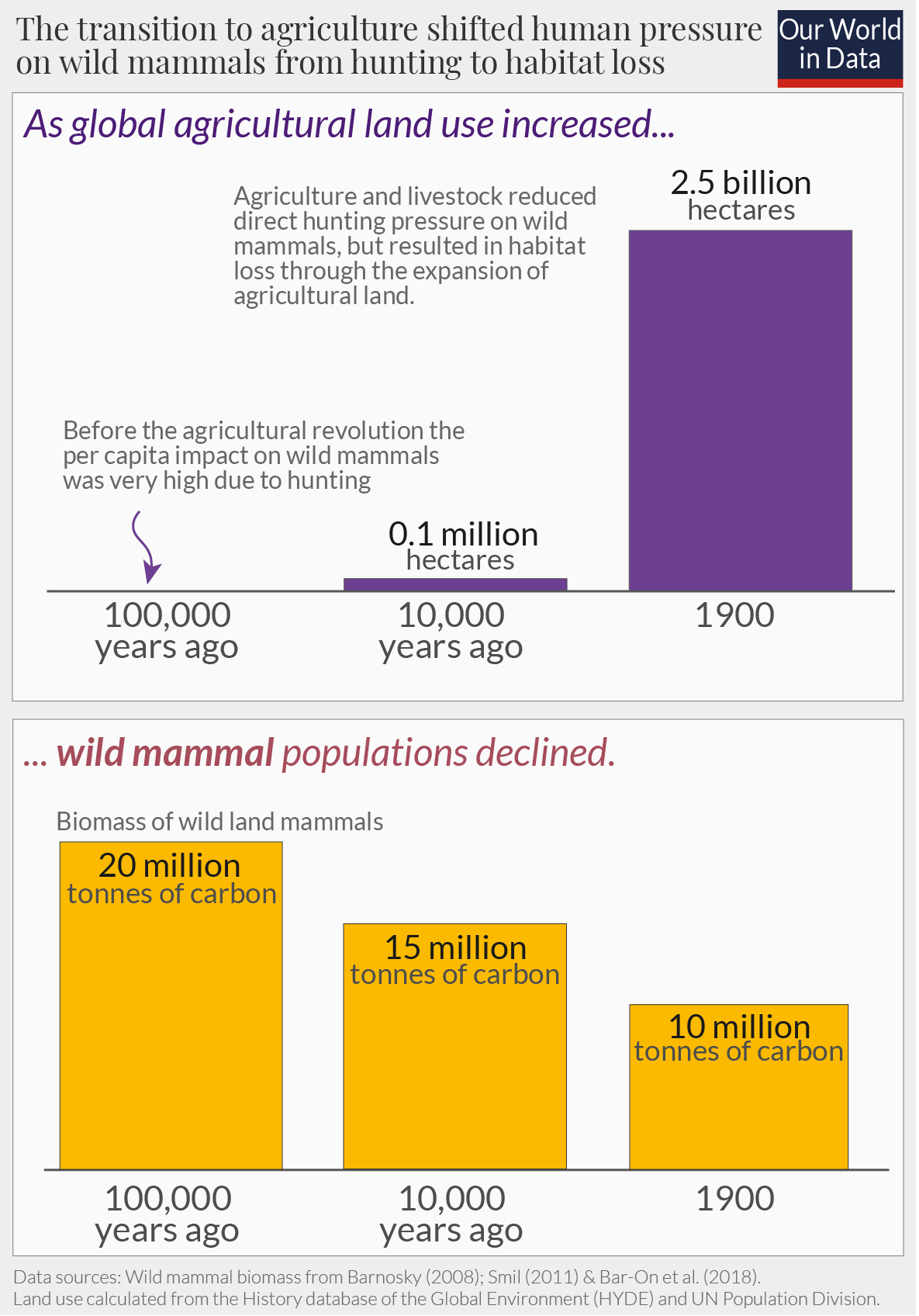
This shift in the distribution has continued through to today. We see this in the final column, which gives the breakdown in 2015. Wild mammals saw another large decline in the last century. At the same time the human population increased, and our livestock even more so. This is because incomes across the world have increased, meaning more people can afford the meat products that were previously unavailable to them. We dig a bit deeper into this distribution of mammals in a related article.
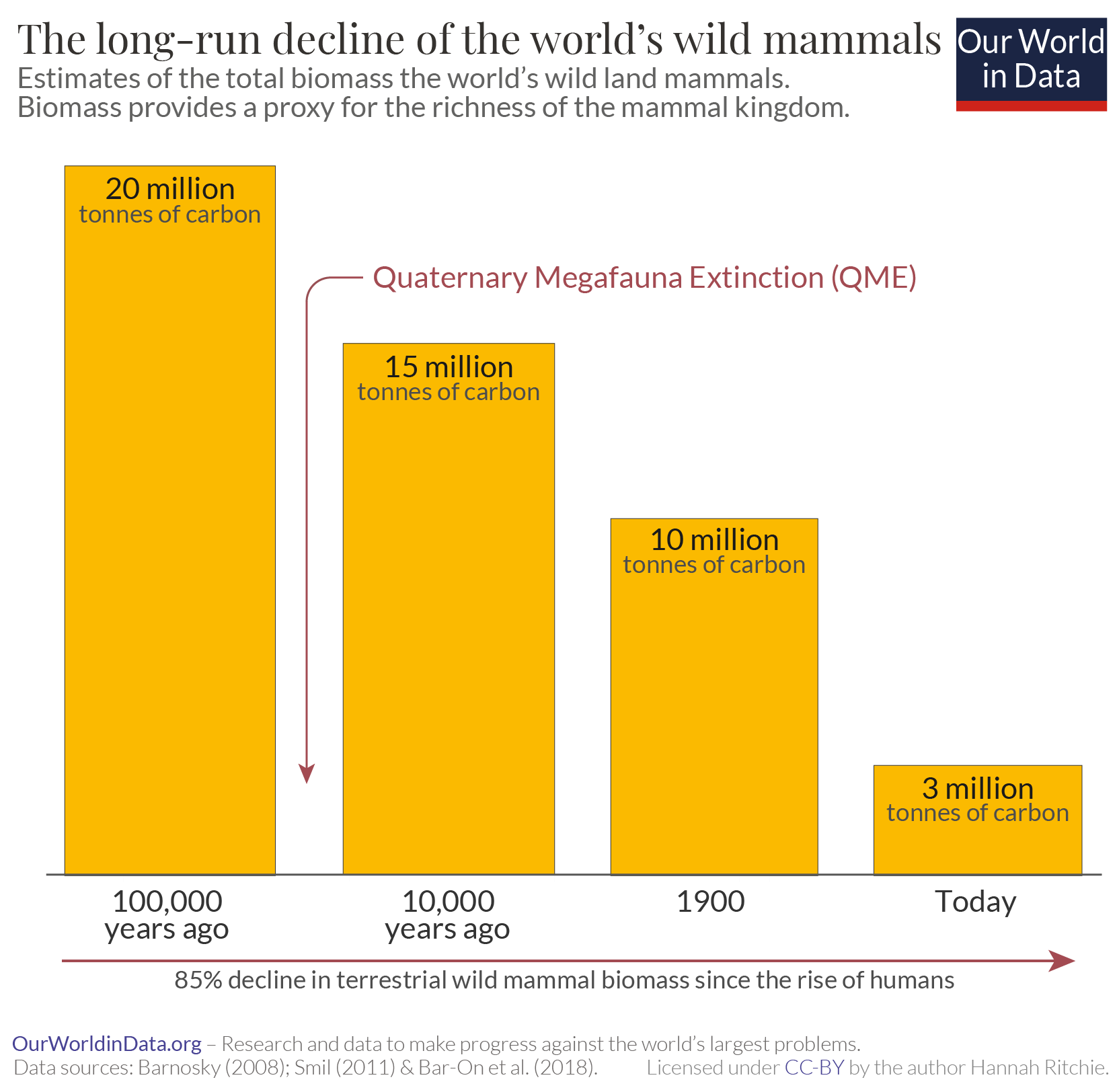
The past was a zero-sum game; the future doesn’t have to be
Since the rise of humans, wild land mammals have declined by 85%.
As we just saw, this history can be divided into two stages. The pre-agriculture phase where our ancestors were in direct competition with wild mammals. They killed them for their meat. And the post-agriculture phase where the biggest impact was indirect: habitat loss through the expansion of farmland. Our past relationship with wild animals has been a zero-sum game: in one way or another, human success has come at the cost of wild animals.
How do we move forward?
Some people suggest a return to wild hunting as an alternative to modern, intensive farming. A return to our primal roots. This might be sustainable for a few local communities. But we only need to do a simple calculation to see how unfeasible this is at any larger scale. In 2018 the world consumed 210 million tonnes of livestock meat from mammals [we’re only looking at mammals here so I’ve excluded chicken, turkey, goose, and duck meat]. In biomass terms, that’s 31 million tonnes of carbon.8 From our chart above we saw that there are only 3 million tonnes of wild land mammal biomass left in the world. If we relied on this for food, all of the world’s wild mammals would be eaten within a month.9
We cannot go back to this hunter-gatherer way of living. Even a tiny number of people living this lifestyle had a massive negative impact on wildlife. For a population of almost 8 billion it’s simply not an option.
But the alternative of continued growth in livestock consumption is also not sustainable. In the short term, it is saving some wild mammals from hunting. But its environmental costs are high: the expansion of agricultural land is the leading driver of deforestation, it emits large amounts of greenhouse gases, and needs lots of resource inputs.
Thankfully we have options to build a better future. If we can reduce agricultural land – and primarily land use for livestock – we can free up land for wild mammals to return. There are already positive signs that this is possible. In the chart we see the change in per capita agricultural land use from 5,000 years ago to today.7 Land use per person has fallen four-fold. The most dramatic decline has happened in the last 50 years: the amount of agricultural land per person has more than halved since 1960. This was the result of increased crop yields and livestock productivity. Of course, the world population also increased over that time, meaning total agricultural land use continued to grow. But, there might be positive signs: the world may have already passed ‘peak agricultural land’. The UN Food and Agriculture Organization reports a decline in global agricultural land since 2000: falling from 4.9 to 4.8 billion hectares. A very small decline, but signs that we could be at a turning point.
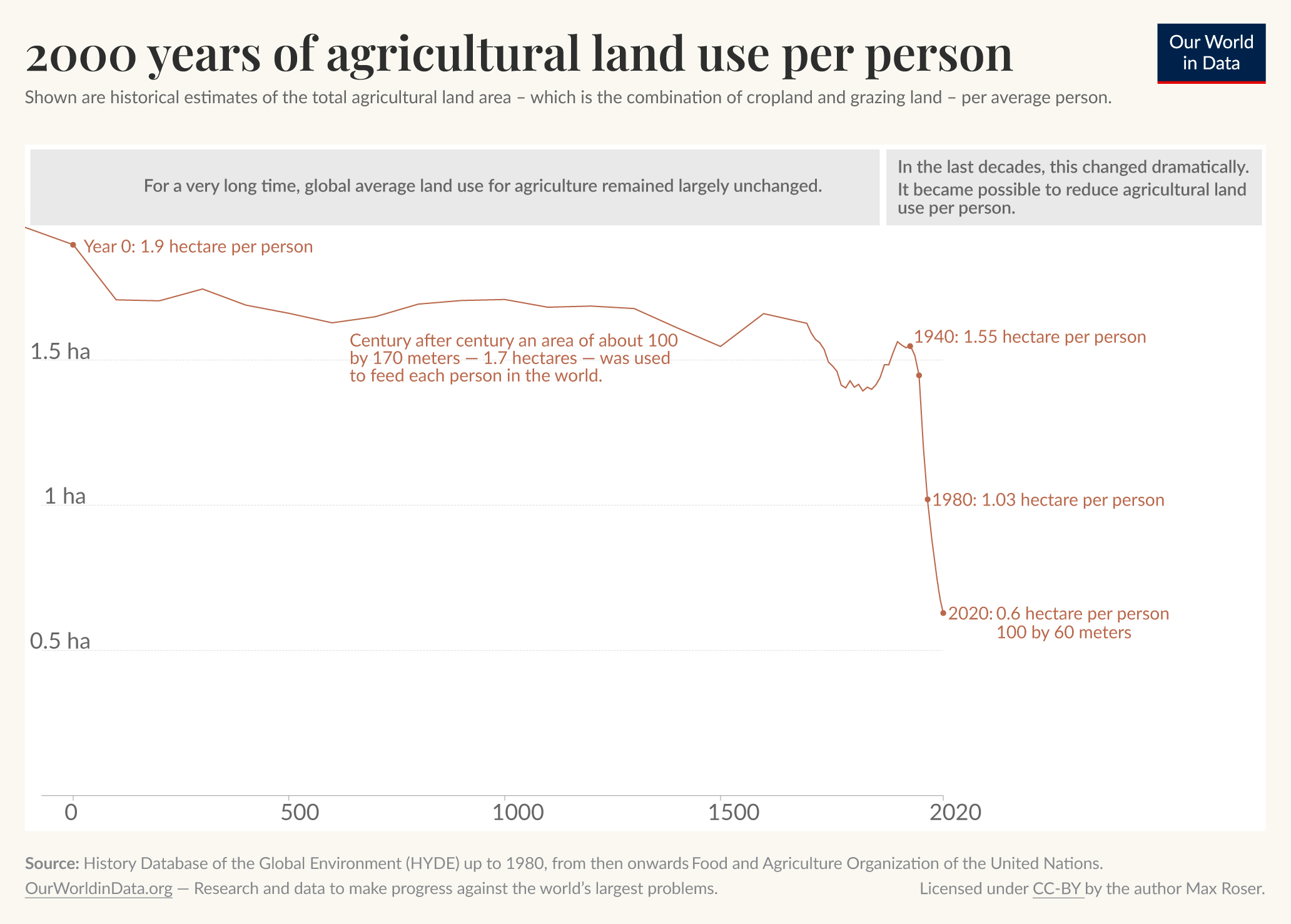
I’ve tried to capture what the future could look like in this final chart. It shows the rise in global agricultural land use over these millennia and the decline in wild biomass that we’ve already seen. But looking to the future, a decline in agricultural land alongside a rise in wild mammals is possible. How can we achieve this?
Some people are in favor of a switch to traditional plant-based diets: cereals, legumes, fruits, and vegetables. Because the land use of plant-based diets is smaller than meat-based diets this is definitely a sustainable option; those who adopt such diets have a low environmental footprint. But many people in the world just really like meat and for those that can afford it, it’s a central part of their diet. For many of those who can’t aspire to be able to do so; we see this when we look at how meat consumption rises with income.
With new technologies it’s possible to enjoy meat or meat-like products without raising or consuming any animals at all. We can have our cake and eat it; or rather, we can have our meat and keep our animals too. Food production is entering a new phase where we can move meat production from the farm to the lab. The prospects for cultured meat are growing. In 2020, Singapore was the first country to bring lab-grown chicken to the market. And it’s not just lab-grown meat that’s on the rise. A range of alternative products using other technologies such as fermentation or plant-based substitutes are moving forward: Beyond Meat, Quorn and Impossible Foods are a few examples.
The biggest barriers – as with all technologies in their infancy – is going to be scale and affordability. If these products are to make a difference at a global scale we need to be able to produce them in large volumes and at low cost. This is especially true if we want to offer an alternative to the standard ‘wild animal to livestock’ transition for lower-income countries. They have to be cheaper than meat.
It’s going to be a challenge. But it’s an incredibly exciting one. For the first time in human history we could decouple human progress from ecological degradation. The game between humans and wild animals no longer needs to be zero-sum. We can reduce poaching and restore old habitats to allow wild mammals to flourish. Doing so does not have to come at the cost of human wellbeing. We can thrive alongside, rather than compete with, the other mammals that we share this planet with.
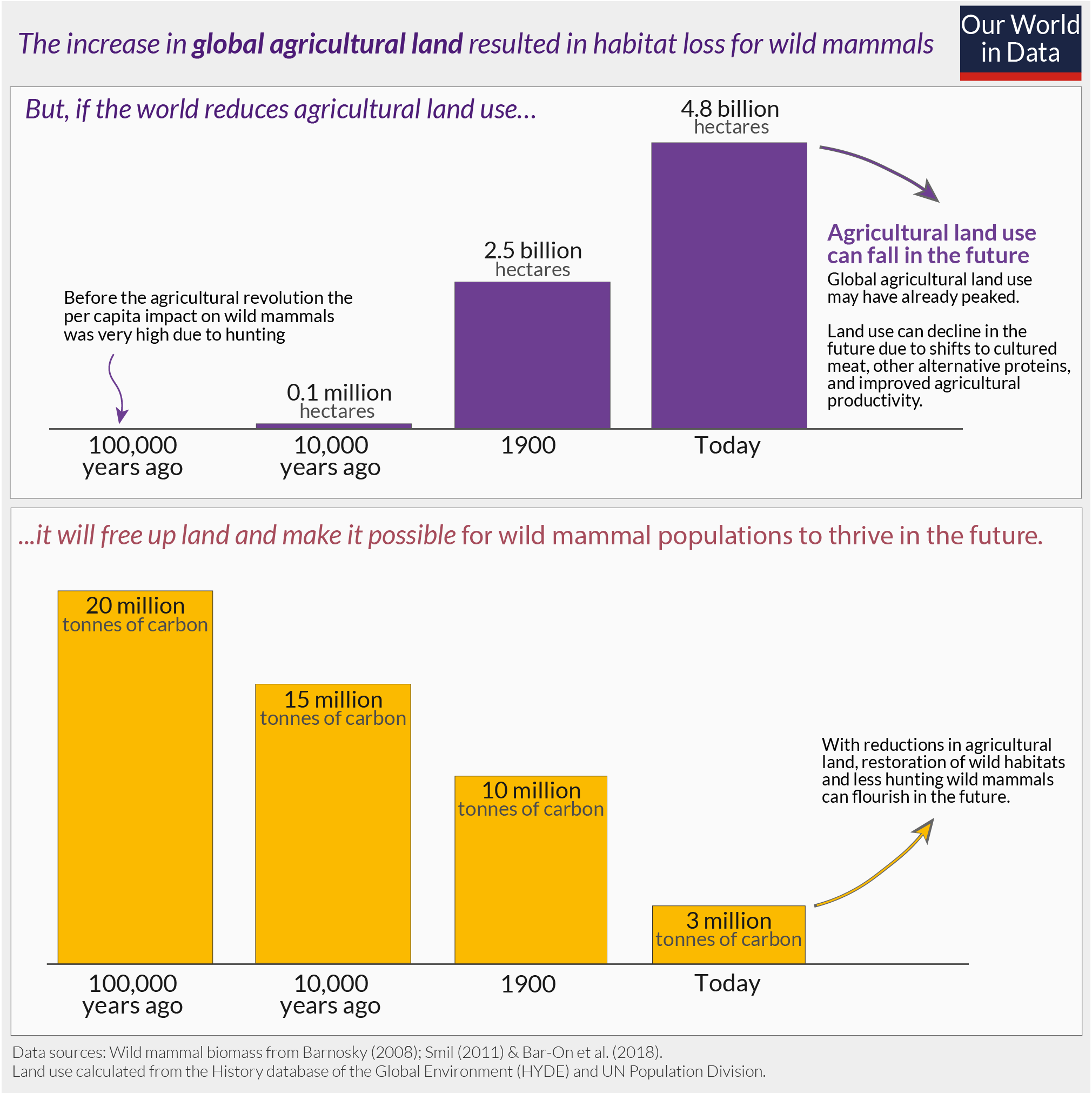
Acknowledgments
Many thanks to Max Roser for the feedback and suggestions on previous versions of this work.
Endnotes
To calculate the biomass of a taxonomic group, the researchers multiplied the carbon stock for a single organism by the number of individuals in that group. In humans, for example, they calculate the average carbon quantity of a person and multiply by the human population. If you want to quickly estimate your carbon biomass: calculate 15% of your weight.
These estimates come from three key sources: pre-human and post-Quaternary extinction figures come from the work of Anthony Barnosky (2008); figures for the year 1900 figures from Vaclav Smil (2011); and 2015 figures from Yinon Bar-On, Rob Phillips and Ron Milo (2018).
The estimates from Anthony Barnosky and Vaclav Smil are based on terrestrial mammal biomass. Phillips and Milo provide a breakdown for both land and marine mammals – for consistency I have used their figures on land mammals only.
Barnosky, A. D. (2008). Megafauna biomass tradeoff as a driver of Quaternary and future extinctions. Proceedings of the National Academy of Sciences, 105(Supplement 1), 11543-11548.
Smil, V. (2011). Harvesting the biosphere: What we have taken from nature. MIT Press.
Bar-On, Y. M., Phillips, R., & Milo, R. (2018). The biomass distribution on Earth. Proceedings of the National Academy of Sciences, 115(25), 6506-6511.
Barnosky, A. D. (2008). Megafauna biomass tradeoff as a driver of Quaternary and future extinctions. Proceedings of the National Academy of Sciences, 105(Supplement 1), 11543-11548.
Andermann, T., Faurby, S., Turvey, S. T., Antonelli, A., & Silvestro, D. (2020). The past and future human impact on mammalian diversity. Science Advances, 6(36), eabb2313.
Smith, F. A., Smith, R. E. E., Lyons, S. K., & Payne, J. L. (2018). Body size downgrading of mammals over the late Quaternary. Science, 360(6386), 310-313.
Klein, R. G., Martin, P. S. (1984). Quaternary Extinctions: A Prehistoric Revolution. United Kingdom: University of Arizona Press.
Barnosky, A. D. (2008). Megafauna biomass tradeoff as a driver of Quaternary and future extinctions. Proceedings of the National Academy of Sciences, 105(Supplement 1), 11543-11548.
Sandom, C., Faurby, S., Sandel, B., & Svenning, J. C. (2014). Global late Quaternary megafauna extinctions linked to humans, not climate change. Proceedings of the Royal Society B: Biological Sciences, 281(1787), 20133254.
At the end of the QME, around 8,000 BC there were around 5 million people globally. In the millennia before this there were even fewer: an estimated 2.4 million in 10,000 BC and 3.6 million in 9,000 BC.
The population of London is around 9 million.
Agricultural land use data was calculated based on land use and population data from the History Database of the Global Environment (HYDE) and UN Population Division.
Ellis, E. C., Beusen, A. H., & Goldewijk, K. K. (2020). Anthropogenic Biomes: 10,000 BCE to 2015 CE. Land, 9(5), 129.
We can estimate tonnes of carbon by multiplying by 15%.
Of course this assumes that we would eat every species of mammal available. If we take into account that some mammal populations might be able to reproduce within this time period, it might be slightly longer than two and a half months, but not much.
Cite this work
Our articles and data visualizations rely on work from many different people and organizations. When citing this article, please also cite the underlying data sources. This article can be cited as:
Hannah Ritchie (2021) - “Wild mammals have declined by 85% since the rise of humans, but there is a possible future where they flourish” Published online at OurWorldInData.org. Retrieved from: 'https://ourworldindata.org/wild-mammal-decline' [Online Resource]BibTeX citation
@article{owid-wild-mammal-decline,
author = {Hannah Ritchie},
title = {Wild mammals have declined by 85% since the rise of humans, but there is a possible future where they flourish},
journal = {Our World in Data},
year = {2021},
note = {https://ourworldindata.org/wild-mammal-decline}
}Reuse this work freely
All visualizations, data, and code produced by Our World in Data are completely open access under the Creative Commons BY license. You have the permission to use, distribute, and reproduce these in any medium, provided the source and authors are credited.
The data produced by third parties and made available by Our World in Data is subject to the license terms from the original third-party authors. We will always indicate the original source of the data in our documentation, so you should always check the license of any such third-party data before use and redistribution.
All of our charts can be embedded in any site.

